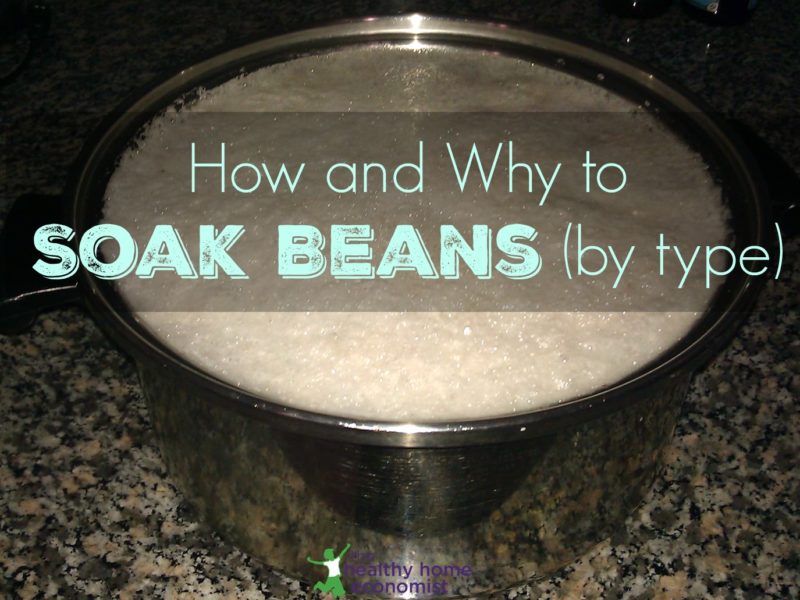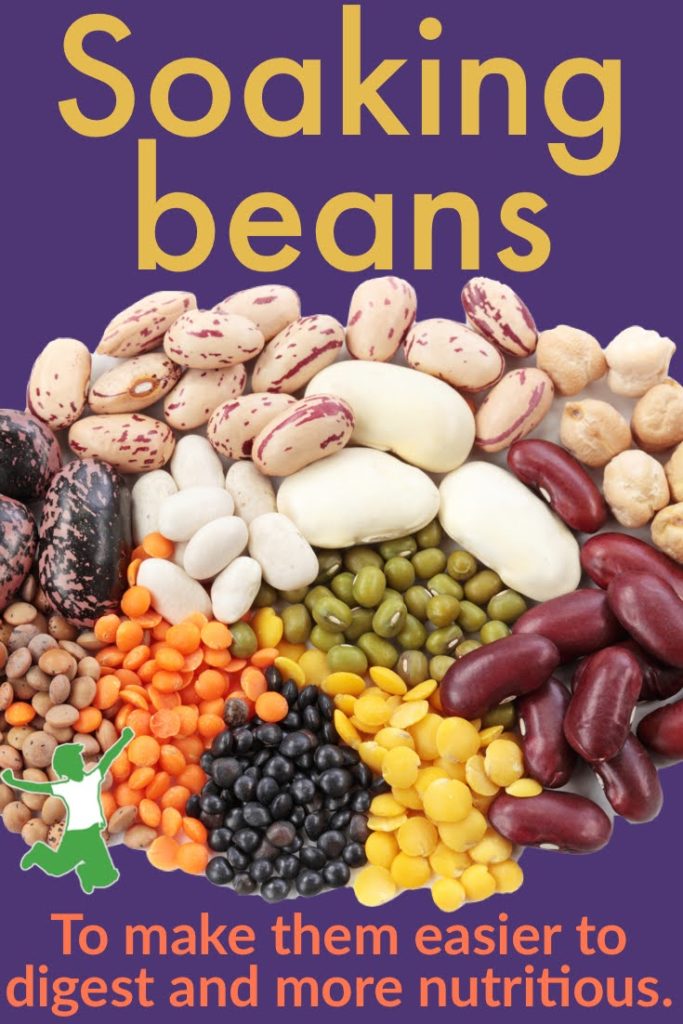Table of Contents[Hide][Show]
The simple overnight process of how to soak beans (by type) will help to eliminate gas and intestinal issues so you can enjoy eating these nutritious plant foods again!

I went on a bean soaking binge this past weekend, and the amount of scum that came to the top of the large pot of soaking kidney beans was so huge, I thought it deserved its own blog post. Soaking beans for many hours before cooking them produces a lot of scum which is course, is rinsed and drained away when the soaking is complete.
What is all that scum anyway? Anti-nutrients, that’s what! And those anti-nutrients such as phytic acid, lectins, and enzyme inhibitors are going to be in your gut causing you gas, heartburn, reflux, and whatever other digestive ills beset you when you eat something that isn’t particularly digestible unless you soak your beans before cooking them.
Traditional cultures took great care to prepare their legumes with a long soak before cooking to enhance digestibility and nutrient absorption.
I love Mexican food but really try to avoid Mexican restaurants for this reason .. they don’t soak their beans before cooking them!
After a meal at a Mexican restaurant, I will typically feel very bloated. Eating the same meal prepared at home where I soaked the beans properly before cooking results in no digestive upset whatsoever.
Take the Soaked Beans Challenge!
If you think unsoaked beans don’t cause you any trouble .. take this challenge. Soak beans next time before cooking and notice the difference in your stomach after eating.
You may think that the unsoaked beans don’t cause you any trouble, but you just may find that soaked beans are infinitely more filling and that you eat less and enjoy the meal more as a result!
Traditional peoples were very wise in the preparation of their foods. They not only selected nutritious foods but they prepared them for maximum digestibility and nutrition.
What good is eating nutritious legumes if the body is so whacked by the anti-nutrients that it can’t very easily extract and digest the nutrition?
So, the next time you make your beans, make sure you soak them first!
I soak large pots of various types of beans every month or so and then cook them – freezing for easy, quick meals when beans are required like homemade chili.
**If you absolutely do not have time to do this, at least buy pre-soaked legumes and beans packed in glass jars. Your digestion will thank you!
How To Prepare Beans by Soaking (video tutorial)
If you’ve never soaked beans before, it’s so easy. It’s a very similar process to soaking nuts. The method also mimics the wisdom of traditional societies that soaked seeds.
See this short video below that demonstrates the simple process.
Kidney shaped beans
For kidney shaped beans and dried/split peas, put a pinch of baking soda and enough water to cover in a large pot and soak uncovered for 12-24 hours. Drain, rinse and cook as usual.
Examples of kidney-shaped beans include:
- Red kidney beans
- White kidney beans (cannellini beans)
- Pinto beans
- Anasazi beans
- Black-eyed beans (black-eyed peas)
- Great Northern beans
- Lima beans
Non-kidney shaped beans (and other legumes)
For more oval-shaped beans and other legumes, soak for 12-24 hours in filtered water to cover plus 1 tablespoon of cider vinegar or lemon juice for every cup of dried beans/legumes used.
A homemade apple cider vinegar recipe or store-bought are both fine (make sure the ACV is packed in glass). Liquid whey from yogurt, kefir, or clabbered milk may also be used. Drain, rinse, and cook as usual.
Examples of non-kidney shaped beans include:
- Black beans (turtle beans)
- Navy beans
- Fava beans
- Adzuki beans
- Chickpeas
- Lentils
For maximum digestibility, it is best to rinse and refresh the filtered water and baking soda or the acidic medium once or twice during the soaking period. If you forget, no worries.
I try to always soak beans for the full 24 hours instead of just overnight. Sometimes if I get busy, I might even soak them 36 hours, but this is risky as they can get moldy sometimes if you go over 24 hours. Best to stay between 12-24 hours particularly during summer months.
How to Cook Beans After Soaking
After soaking, be sure to thoroughly drain and rinse the beans until all the scum is washed away. Then, complete the process by doing the following.
- Fill the pot of rinsed pre-soaked beans with fresh filtered water, bring to a boil, and skim away any additional foam that may come to the top at the start of the boil.
- Turn down the heat to a simmer, add 4 crushed garlic cloves, and cook until the beans are soft (about 4 hours).
- Drain beans and add to your favorite dish or let cool and freeze in large freezer bags for quick meals at a later date!
You won’t be needing over-the-counter gas meds after preparing beans the traditional way!
Should You Use the Soaking or Cooking Water?
Some alternative cooking circles advocate using the soaking or bean cooking water. Unfortunately, neither of these practices is traditional.
Using the cooked bean water or aquafaba is actually a dangerous practice. See the linked article for reasons to avoid this modern food especially during pregnancy!
Other Types of Legumes
This article plus video on soaking lentils provide additional information specifically for this legume. Because they are soaked exactly the same as all non-kidney shaped beans, it is helpful for visual learners.
Lentils were the favorite of nutritional pioneer Dr. Weston A. Price due to their very high potassium content.
Recipes Using Pre-soaked Beans and Legumes
Here are some recipes to try using soaked beans and other legumes to entice you!









Thanks for this article. I came to it by doing a search for why can I eat/drink chickpea water especially from canned chickpeas when it has lectins in it? I always rinse my canned beans well before eating, including chickpeas. But more and more recipes call for using the chickpea water.
I personally would never drink chickpea water with the potential for ingesting large amounts of anti-nutrients.
You have clearly specified filtered water. My city water supply is high quality but high pH. Why must it be filtered?
City water is full of toxins including chlorine and many other things that you don’t want mixing with your food. A couple of articles on how to best filter your water. https://www.thehealthyhomeeconomist.com/whole-house-water-filter/
https://www.thehealthyhomeeconomist.com/choosing-best-water-filter-for-your-home/
What an interesting article. THANK YOU!!!
I have been soaking beans for years and am a big believer in the benefits. You mention in the last comment that the sources are listed, I too, am curious about the differences in bean type needing acid or not. What does the shape have to do with it? Thanks in advance
Thank you!
I am curious why kidney shaped beans get no acid and the other shapes do. I have never heard that before, what is the science behind that. Thanks!
Some types of beans release anti-nutrients at a different pH than others. References provided in the article. If that isn’t convincing, simply eat beans soaked and unsoaked. Notice how much gas, bloating and discomfort you experience with unsoaked (but cooked) beans than soaked and cooked (typically no discomfort experienced at all).
Hi Sarah!
I love all your articles and refer to them often! Thank you for all that you do…
A question about beans… I always soak dried beans but have been getting access to fresh ones recently… would you soak fresh beans? If so for how long? If not, what about the anti nutrients?
Thanks! ????
The soaking process would be the same 🙂
With Instant Pot’s popularity, others are saying you don’t have to soak. I have had no bad side effects from not soaking. Have you experienced any differences with pressure cooking them?
I personally will only eat beans and legumes that have been soaked before cooking whether conventionally or in an instant pot. I notice that I eat far less and feel full longer. I also don’t get any bloating when they are soaked. I haven’t seen any research that cooking in an instant pot without soaking reduces the anti-nutrients as effectively as a prolonged soak plus cooking.
I don’t want to sound silly, but which category do pinto beans fall into??
Thank you!
Soak pinto beans like kidney beans.
I followed this recipe exactly and my chickpeas never softened, even though I kept them cooking 24 hours. I tried again the next day with chickpeas from the same bag, no lemon juice, and they cooked fine, so it wasn’t the age of the beans.